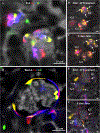Novel fluorescence techniques to quantitate renal cell biology
- PMID: 31493823
- PMCID: PMC6748388
- DOI: 10.1016/bs.mcb.2019.04.013
Novel fluorescence techniques to quantitate renal cell biology
Abstract
Fluorescence microscopy techniques are powerful tools to study tissue dynamics, cellular function and biology both in vivo and in vitro. These tools allow for functional assessment and quantification along with qualitative analysis, thus providing a comprehensive understanding of various cellular processes under normal physiological and disease conditions. The main focus of this chapter is the recently developed method of serial intravital multiphoton microscopy that has helped shed light on the dynamic alterations of the spatial distribution and fate of single renal cells or cell populations and their migration patterns in the same tissue region over several days in response to various stimuli within the living kidney. This technique is very useful for studying in vivo the molecular and cellular mechanisms of tissue remodeling and repair after injury. In addition, complementary in vitro imaging tools are also described and discussed, like tissue clearing techniques and protein synthesis measurement in tissues in situ that provide an in depth assessment of changes at the cellular level. Thus, these novel fluorescence techniques can be effectively leveraged for different tissue types, experimental conditions as well as disease models to improve our understanding of renal cell biology.
Keywords: Fluorescent reporter; Intravital imaging; Multiphoton microscopy; Podocyte; Protein synthesis; Tissue remodeling.
© 2019 Elsevier Inc. All rights reserved.
Figures






Similar articles
-
Intravital Imaging of Human Melanoma Cells in the Mouse Ear Skin by Two-Photon Excitation Microscopy.Methods Mol Biol. 2018;1755:223-232. doi: 10.1007/978-1-4939-7724-6_15. Methods Mol Biol. 2018. PMID: 29671273 Free PMC article.
-
Novel in vivo techniques to visualize kidney anatomy and function.Kidney Int. 2015 Jul;88(1):44-51. doi: 10.1038/ki.2015.65. Epub 2015 Mar 4. Kidney Int. 2015. PMID: 25738253 Free PMC article. Review.
-
Long-Term Cell Fate Tracking of Individual Renal Cells Using Serial Intravital Microscopy.Methods Mol Biol. 2020;2150:25-44. doi: 10.1007/7651_2019_232. Methods Mol Biol. 2020. PMID: 31087287 Free PMC article.
-
Quantitative Intravital Calcium Imaging in Mouse Kidney.Methods Mol Biol. 2025;2861:187-193. doi: 10.1007/978-1-0716-4164-4_14. Methods Mol Biol. 2025. PMID: 39395106
-
In vivo microscopy.Nephrol Ther. 2016 Apr;12 Suppl 1(Suppl 1):S21-4. doi: 10.1016/j.nephro.2016.01.004. Epub 2016 Mar 8. Nephrol Ther. 2016. PMID: 26968479 Free PMC article. Review.
Cited by
-
Longitudinal tracking of acute kidney injury reveals injury propagation along the nephron.Nat Commun. 2023 Jul 21;14(1):4407. doi: 10.1038/s41467-023-40037-y. Nat Commun. 2023. PMID: 37479698 Free PMC article.
-
A new view of macula densa cell protein synthesis.Am J Physiol Renal Physiol. 2021 Dec 1;321(6):F689-F704. doi: 10.1152/ajprenal.00222.2021. Epub 2021 Oct 25. Am J Physiol Renal Physiol. 2021. PMID: 34693742 Free PMC article.
-
A new view of macula densa cell microanatomy.Am J Physiol Renal Physiol. 2021 Mar 1;320(3):F492-F504. doi: 10.1152/ajprenal.00546.2020. Epub 2021 Jan 25. Am J Physiol Renal Physiol. 2021. PMID: 33491562 Free PMC article.
-
Beyond conventional microscopy: Observing kidney tissues by means of fourier ptychography.Front Physiol. 2023 Feb 13;14:1120099. doi: 10.3389/fphys.2023.1120099. eCollection 2023. Front Physiol. 2023. PMID: 36860516 Free PMC article.
-
Sparsentan improves glomerular hemodynamics, cell functions, and tissue repair in a mouse model of FSGS.JCI Insight. 2024 Sep 3;9(19):e177775. doi: 10.1172/jci.insight.177775. JCI Insight. 2024. PMID: 39226116 Free PMC article.
References
-
- Basile DP, Friedrich JL, Spahic J, Knipe N, Mang H, Leonard EC, et al. (2011). Impaired endothelial proliferation and mesenchymal transition contribute to vascular rarefaction following acute kidney injury. American Journal of Physiology. Renal Physiology, 300(3), F721–F733. 10.1152/ajprenal.00546.2010. - DOI - PMC - PubMed
Publication types
MeSH terms
Substances
Grants and funding
LinkOut - more resources
Full Text Sources

